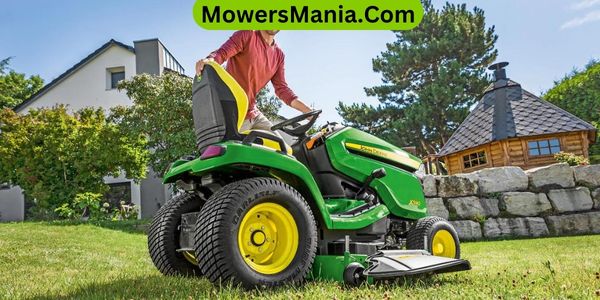So, you’ve been driving your mower around, thinking it’s all good, but have you ever really taken a closer look at its drive system? It’s easy to forget about this crucial component, but neglecting it can lead to a whole world of problems.
Just imagine the frustration of a stalled mower in the middle of a job. But fear not, because in the next few minutes, you’ll learn how to properly clean and inspect the drive system on your mower, ensuring its smooth operation and longevity.

Stick around to uncover the secrets of drive system maintenance that will keep your mower running like a dream.
Importance of Drive System Maintenance
Regular maintenance of your mower’s drive system is crucial for ensuring optimal performance and longevity.
By regularly inspecting and cleaning the drive system, you can prevent issues such as belt slippage, decreased traction, and premature wear on the drive components.
Neglecting this maintenance can lead to costly repairs and a shortened lifespan for your mower. The drive system is a vital component responsible for transferring power from the engine to the wheels or tracks, enabling the mower to move efficiently and effectively.
Without proper maintenance, the drive system can become clogged with debris, worn-out components, or damaged belts, ultimately compromising its functionality.
Additionally, neglecting drive system maintenance can result in decreased maneuverability and uneven cutting, impacting the overall quality of your lawn maintenance.
Therefore, by prioritizing regular cleaning and inspection of the drive system, you can proactively address potential issues, extend the life of your mower, and ensure consistent, high-quality performance.
Tools and Supplies Needed
You’ll need a few basic tools and supplies for inspecting and cleaning the drive system of your mower.
These include:
- Socket set
- Screwdriver
- Wire brush
- Rag for cleaning
The inspection process and cleaning procedure will be covered in the following sections.
Required Tools
To complete the cleaning and inspection of the drive system on your mower, you’ll need a set of basic hand tools and supplies.
The required tools include:
- Socket and ratchet set
- Screwdrivers
- Pliers
- Wire brush
- Torque wrench
Additionally, you’ll need safety goggles, gloves, and a cleaning brush.
These tools will enable you to:
- Remove any debris
- Inspect the drive belt for wear
- Ensure that all components are properly lubricated
The socket and ratchet set will be essential for:
- Removing the drive belt cover
- Accessing the drive system components
Screwdrivers and pliers will help with:
- Any fasteners or connections that need to be adjusted or removed
The wire brush will assist in cleaning any built-up debris, and the torque wrench will ensure proper tightening of components during reassembly.
Inspection Process
When beginning the inspection process of the drive system on your mower, gather the necessary tools and supplies to ensure a thorough examination.
You’ll need a flashlight to illuminate hard-to-see areas, a rag for wiping down parts, and a wrench or pliers for removing any components if necessary.
Additionally, have a can of lubricant on hand to apply to the drive system to ensure smooth operation.
A jack or lift may be needed to elevate the mower for a more comprehensive inspection.
Lastly, it’s advisable to have a notepad and pen to jot down any issues or maintenance tasks that need to be addressed.
With these tools and supplies at your disposal, you’ll be well-equipped to carry out a detailed examination of your mower’s drive system.
Cleaning Procedure
As you prepare to clean the drive system on your mower, gather the necessary tools and supplies for the task, ensuring a thorough examination.
Here’s what you’ll need:
- Tools:
- Socket set: To remove any bolts or nuts securing the drive system components.
- Wire brush: For scrubbing off any built-up debris and grime on the drive system parts.
- Supplies:
- Degreaser: Use a suitable degreaser to break down grease and oil buildup on the drive system.
- Clean rags: These will come in handy for wiping down the drive system components after cleaning.
Gathering these tools and supplies will ensure that you have everything needed to effectively clean the drive system on your mower.
Steps for Cleaning the Drive System

You can start cleaning the drive system by removing any debris or grass clippings using a brush or compressed air. Ensure that the mower is turned off and the spark plug wire is disconnected before you begin.
Once you’ve cleared the visible debris, inspect the drive belt for any signs of wear, cracking, or fraying. If you notice any damage, it’s crucial to replace the belt to maintain the efficiency of the drive system.
Next, examine the drive wheels for any buildup of dirt or grass. Use a wire brush or a damp cloth to carefully remove any accumulated debris. It’s important to pay close attention to the drive wheel gears and axles, ensuring they’re free from dirt and well lubricated.
Lubricate any moving parts according to the manufacturer’s recommendations.
Finally, perform a test run to ensure that the drive system is functioning smoothly.
Steps for Inspecting the Drive System
Now it’s time to inspect the drive system of your mower.
Start by checking the belt tension to ensure it’s properly adjusted.
Next, inspect the gearbox for any signs of wear or damage.
Lastly, identify and lubricate the necessary points to keep the drive system running smoothly.
Belt Tension Check
How can you ensure the proper tension of the drive belt on your mower’s drive system?
To check the belt tension, follow these steps:
- Visual Inspection:
- Look for any signs of wear, damage, or fraying on the belt.
- Ensure that the belt is properly aligned on the pulleys and not slipping off.
Proper tension is crucial for the drive system to function effectively and prevent premature wear on the belt. If the belt appears loose or worn, it may need to be adjusted or replaced.
Gearbox Inspection
When inspecting the drive system of your mower, start by examining the gearbox for any signs of wear, damage, or leakage. Check for any unusual noises or vibrations when the gearbox is engaged. Ensure that the gearbox oil level is within the recommended range and that the oil is clean.
Look for any loose or damaged components such as gears, bearings, or seals. Inspect the gearbox housing for cracks or dents that may affect its integrity.
If you notice any issues during the inspection, it’s important to address them promptly to prevent further damage to the gearbox and ensure the proper functioning of the drive system.
Regular gearbox inspection and maintenance can help prolong the lifespan of your mower and prevent costly repairs.
Lubrication Points Identification
Examine the gearbox thoroughly to identify the lubrication points and ensure that they’re properly greased for the smooth operation of the drive system on your mower. Proper lubrication is crucial for reducing friction and wear, ultimately extending the lifespan of your mower’s drive system.
To identify the lubrication points:
- Look for grease fittings: These are small, usually metal, fittings located on the gearbox where grease can be applied.
- Use a grease gun: Once you’ve located the grease fittings, use a grease gun to apply the appropriate amount of grease to each point. This will ensure that the gears and other moving parts are properly lubricated for optimal performance.
Regularly inspecting and greasing these lubrication points will help maintain the efficiency and longevity of your mower’s drive system.
Common Issues to Look Out For
Keep an eye out for any unusual sounds or vibrations while operating your mower’s drive system. These could be signs of underlying issues that need attention.
If you notice any grinding, squealing, or clunking noises, it could indicate worn-out or damaged components such as belts, pulleys, or bearings. Addressing these issues promptly can prevent further damage to the drive system.
Another common issue to watch for is slipping or loss of power in the drive system. This could be caused by a loose or worn drive belt, which may need adjustment or replacement.
Additionally, inspect the drive pulleys for any signs of wear or damage that could affect the belt’s performance.
Pay attention to any difficulty in engaging or disengaging the drive system. This could be due to problems with the clutch or cable, and it’s essential to address these issues to ensure smooth operation of the drive system.
Lastly, check for any leaks of oil or grease around the drive system components. Leaks can indicate seal or gasket failures, and addressing them promptly can prevent further damage and ensure proper lubrication of the drive system.
Regularly inspecting your mower’s drive system for these common issues can help maintain its optimal performance and prevent costly repairs down the road.
Maintenance Schedule and Tips

To maintain the optimal performance of your mower’s drive system, it’s essential to follow a regular maintenance schedule and implement the following tips for upkeep.
- Regular Maintenance Schedule
- Check and Replace Belts: Inspect the belts for any signs of wear and tear, and replace them if necessary to ensure proper functioning of the drive system.
- Lubrication of Moving Parts: Regularly lubricate the moving parts of the drive system to prevent friction and ensure smooth operation.
Frequently Asked Questions [FAQs]
Can I Use a Pressure Washer to Clean the Drive System on My Mower?
Yes, you can use a pressure washer to clean the drive system on your mower. However, be cautious not to use too high of pressure, as it can damage the components. Afterwards, inspect for any wear or damage.
How Often Should I Check the Tension of the Drive Belt on My Mower?
You should check the tension of the drive belt on your mower at least once a season. Regular maintenance helps prevent wear and ensures optimal performance. If it feels loose or shows signs of damage, it’s time for a replacement.
What Type of Lubricant Should I Use for the Drive System Components?
You should use a lithium-based grease or a specialized dry lubricant for your drive system components. These lubricants will help reduce friction and wear, keeping your mower’s drive system in good condition for longer.
Is It Necessary to Remove the Drive System Components for a Thorough Inspection?
You don’t need to remove the drive system components for inspection, but it’s a good idea to clean them. Start by removing any debris, checking for wear and tear, and then lubricating the moving parts for smooth operation.
Can I Use a Regular Household Cleaner to Clean the Drive System, or Do I Need a Specific Type of Cleaner?
You can use a regular household cleaner to clean the drive system, but it’s essential to ensure it’s safe for the materials in the drive system. Check the manufacturer’s recommendations for specific cleaner types.
Conclusion
Now that you’ve learned how to clean and inspect the drive system on your mower, you can ensure that it stays in good working condition.
Regular maintenance will help prevent issues and keep your mower running smoothly.
Don’t forget to follow the maintenance schedule and keep an eye out for any common issues.
With these simple steps, you can keep your drive system in top shape for years to come.



